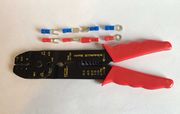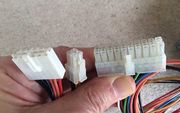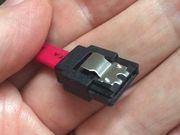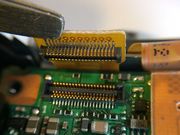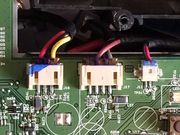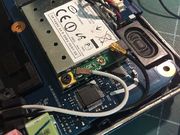Connectors: Difference between revisions
No edit summary |
No edit summary |
||
| Line 25: | Line 25: | ||
===Latched connectors=== | ===Latched connectors=== | ||
[[File:Latched power connectors.jpg|180px|thumb|left|Latched power connectors on a standard desktop power supply.]] | |||
[[File:Latched SATA connector.jpg|180px|thumb|right|A latched SATA cable connector.]] | [[File:Latched SATA connector.jpg|180px|thumb|right|A latched SATA cable connector.]] | ||
Quite commonly, a connector has a latch of some kind to prevent it shaking or being pulled loose. They are very common in automotive electrics where continual vibration could cause a connector to shake loose, but they are often seen in domestic items as well, particularly for power connectors. | Quite commonly, a connector has a latch of some kind to prevent it shaking or being pulled loose. They are very common in automotive electrics where continual vibration could cause a connector to shake loose, but they are often seen in domestic items as well, particularly for power connectors. The connectors used to connect a standard desktop computer power supply to the motherboard are of this type. | ||
If a connector refuses to disengage, never pull hard on the wires, as they may break. Look for some kind of latch or catch. There are various types and you may have to examine it closely in order to determine how to pull, push, squeeze or lever it. Pulling on the connector as you squeeze the latch may prevent the latch from disengaging. Try squeezing ''then'' pulling. Sometimes a small flat screwdriver judiciously applied will help. | If a connector refuses to disengage, never pull hard on the wires, as they may break or pull out of the connector. Look for some kind of latch or catch. There are various types and you may have to examine it closely in order to determine how to pull, push, squeeze or lever it. Pulling on the connector as you squeeze the latch may prevent the latch from disengaging. Try squeezing ''then'' pulling. Sometimes a small flat screwdriver judiciously applied will help. | ||
Some SATA disk data cables also have a latch, which you have to squeeze, sometimes quite hard, in order to release. | Some SATA disk data cables also have a latch, which you have to squeeze, sometimes quite hard, in order to release. | ||
Revision as of 16:21, 12 April 2018
Connectors and their secrets.
Summary
Nearly all electrical and electronic equipment contains connectors. Some of these are very small or have latches or clamps to keep them connected. You can save frustration and possibly causing damage by being prepared for whatever you might meet.
Safety
- Equipment should be powered off before connectors are disengaged or re-engaged since all the connections in a multi-way connector may not be made or broken at precisely the same time. This could potentially cause damaging voltages or currents in the device.
Introduction
Connectors allow a device or appliance to be built out of various parts, modules or sub-assemblies which can be easily put together on an assembly line, but also allowing them to be taken apart for repair. A connector must provide a good electrical contact rated for the voltages and currents involved, must resist coming undone if subject to vibration or stress, and must fit within the physical size constraints of the device it serves. There are many different types of connectors which meet these demands in different ways.
Full size connectors
The connectors in household and kitchen appliances and power tools rarely cause problems except that they may be very stiff to undo. Occasionally they may have latches, which might not be immediately obvious, to prevent them accidentally coming adrift. (This is very common in vehicle electrics, which is likely to be subject to vibration.)
Crimp terminals
There are several types of crimp terminals which are colour coded according to the diameter of wire they are intended for.
Spade terminals are very commonly found in domestic appliances, and simply consist of a flat piece of metal like a garden spade (though obviously much smaller). It may be attached to or part of a switch, an electric motor, or some other component, and a receptacle slides onto it to make a connection. After a number of years these can become very stiff to remove.
Fork and ring terminals are used for terminating a wire which is to be connected under a screw.
Male and female bullet terminals allow an in-line connection between two wires.
Latched connectors
Quite commonly, a connector has a latch of some kind to prevent it shaking or being pulled loose. They are very common in automotive electrics where continual vibration could cause a connector to shake loose, but they are often seen in domestic items as well, particularly for power connectors. The connectors used to connect a standard desktop computer power supply to the motherboard are of this type.
If a connector refuses to disengage, never pull hard on the wires, as they may break or pull out of the connector. Look for some kind of latch or catch. There are various types and you may have to examine it closely in order to determine how to pull, push, squeeze or lever it. Pulling on the connector as you squeeze the latch may prevent the latch from disengaging. Try squeezing then pulling. Sometimes a small flat screwdriver judiciously applied will help.
Some SATA disk data cables also have a latch, which you have to squeeze, sometimes quite hard, in order to release.
Ribbon connectors
Flexible ribbons with conducting tracks similar to printed circuit tracks are extensively used in portable electronic equipment such as cameras, laptops, smartphones and tablets. Several types of connector are used to connect these to a circuit board.
Snap-on connectors
A multi-way plug soldered to the ribbon mates with a socket mounted on the circuit board. To release, lift a corner of the plug with a fingernail or plastic opening tool and it should snap open very easily.
Reseating these can be a little more tricky as the plug and socket need to be correctly aligned, which is often difficult to see as the socket is generally hidden by the ribbon. A little patience may be required to find the correct alignment. Do not try to force it or you may damage it. When correctly aligned, with firm (but not forceful) finger pressure you will be able to feel it snap closed. Press both ends to make sure it's closed along its entire length.
Having closed one of these connectors it can pop open again if the ribbon is strained, for example if it's attached to a sub-assembly which has not yet been screwed back in place.
Battery connectors in smartphones and tablets are often of the snap-on variety, though of larger dimensions. You might think that makes them easier to work with, but this isn't always the case as considerably more force may be required to release them. Applied in the wrong way, this can sometimes cause the socket to detach from the board, which would be hard to repair.
Zero insertion force connectors
With these, there is no plug attached to the ribbon, but instead, the conducting tracks are exposed at the end and often gold plated. The end of the ribbon is inserted into the connector and then clamped in place with a small bar.
There are two types. In one, the bar has to be angled up with a fingernail or plastic opening tool to release the ribbon. In the other, the bar has a tab at each end which has to be pulled away from the body of the socket.
In both cases the release mechanism is delicate. It can normally be opened quite easily but too much force or force applied in the wrong way can break it. Repair would then involve microsoldering to replace the socket, though there is some chance you could clamp the ribbon by inserting a piece of card or plastic of the right thickness into the connector.
On reassembly it may take a little fiddling to get the ribbon to go into a narrow slot in the connector. Make sure the release bar is in the fully open position and that the ribbon is fully home before closing the clamping bar.
Push-fit connectors
In the simplest type of ribbon connector the end of the ribbon is reinforced by a slightly stiffer layer bonded to it. This is forced into the a connector containing contacts which grip it from both sides.
Before attempting to disconnect it, first make sure it isn't a zero insertion force connector with a locking mechanism. If not, pull on the reinforcing plastic if you can with tweezers, if not, pull on the ribbon itself. Sometimes the ribbon will have a right angle bend close to the end, in which case it's easy to tear it on the inside of the bend if you're not careful. If you were to do that your only hope would probably be to cannibalise a ribbon out of another faulty device of the same type.
To reconnect it, simply push the ribbon into the slot in the connector. The slot is a millimetre or less off the board and it sometimes takes just a little bit of fiddling to find it. Make sure the ribbon is pushed fully home, by pushing on the reinforcement if you can. There is sometimes a line printed on the ribbon how far it should go in.
Photos needed: each type of ribbon connector
Miniature connectors
JST and similar connectors are often used to connect multiple wires to a circuit board. They come in different sizes, some of them very tiny. To release them, never just pull on the wires as they may break or come away from the connector. The plug is slightly wider at the top allowing you, instead, to pull on it with your fingernails, or for the smaller ones, tweezers whilst pulling gently on the wires. Pulling alternately on the two ends of the plug often helps.
Smartphones, tablets, laptops and WiFi routers use miniature co-axial plugs and sockets to connect the aerial leads to the circuit board. Gently lift off with a fingernail or plastic opening tool. They can be reconnected with firm finger pressure but careful alignment is required. You should be able to feel them snap closed.
Elastomeric connectors
Photo needed
Many devices contain a simple LCD display, usually monochrome, and displaying 7-segment numbers and maybe various status icons, or sometimes a low resolution graphic display. The most familiar examples are calculators, DECT and older mobile phones.
The LCD is glass and the connections on it are almost invisible conductive tracks deposited on the surface of the glass. An elastometric strip, also known as a ZEBRA connector, is a very simple and common method of making the connections between the display and a printed circuit board. The board has one or two rows of contacts exactly matching those on the LCD and the elastometric strip is sandwiched between them. This makes all the connections since it consists of alternating conductive and non-conductive rubber (or some rubber-like plastic) along its length. With several such layers per connection, no special alignment is needed.
The elastometric strip is under pressure between the LCD and the circuit board so as to make good contact, but with age it can loose its springiness, typically resulting in some segments of a 7-segment display no longer working, or one or more rows or columns of pixels in a graphic display failing. If you can arrange to increase the pressure on the strip this may help, or you could try gently squashing it in a direction at right angles to the normal pressure before refitting it.
External links
- iFixit has an excellent guide on Recognizing & Disconnecting Cable Connectors.
